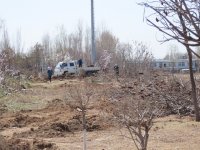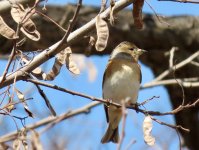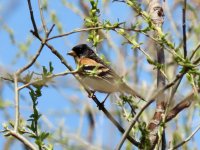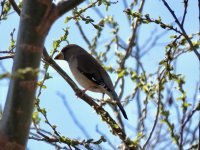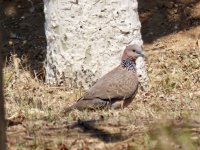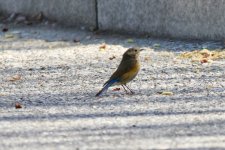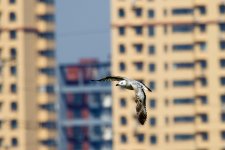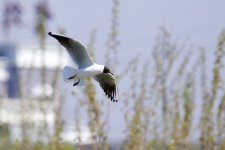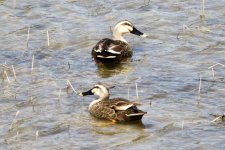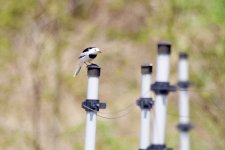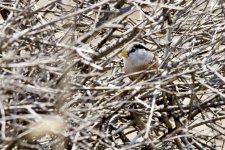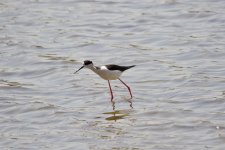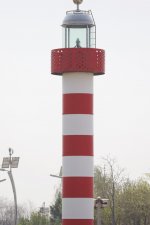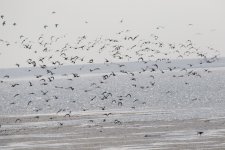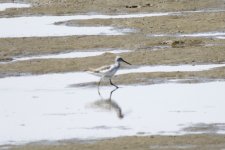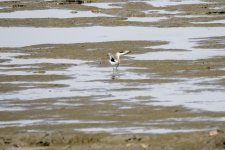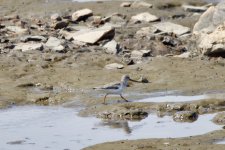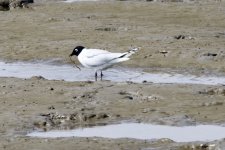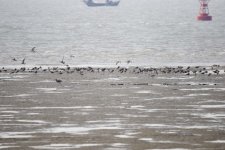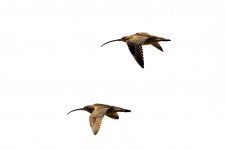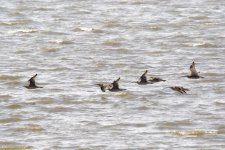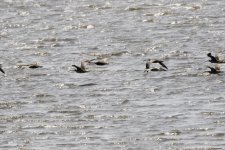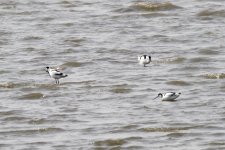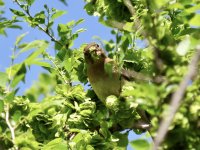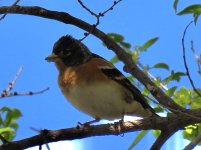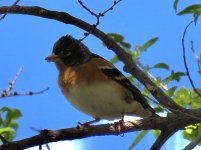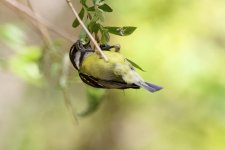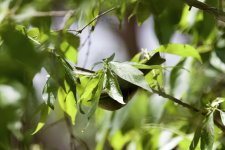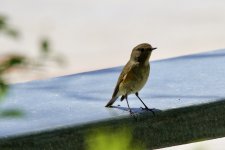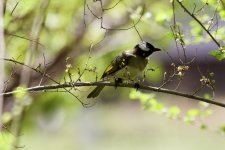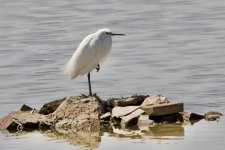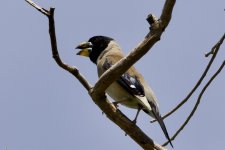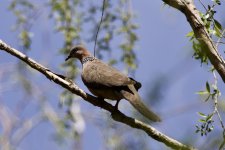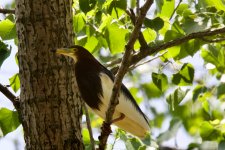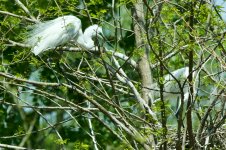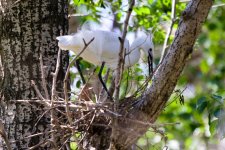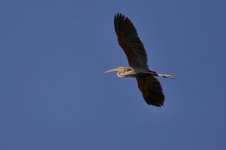May 11, 2021 - DingXiang Bird Paradise rookery
The nicest day of the year so far, so my wife managed to ascertain that the DingXiang "Bird Paradise" rookery was finally reopened. Therefore we decided to cough up the 200 RMB to get a car and pay the 100 RMB each entry fee to check out what always is a great place to bird. Being a weekday there was not too much of a crowd, with only one tour bus showing up and I avoided them easily by poking around for accipitors in little traversed corners. Of course the standard retinue of
Great Egret, Intermediate Egret, Little Egret, Purple Heron, Grey Heron, Chinese Pond Heron, Black-Crowned Night-Heron and
Cattle Egret where nesting in the rookery area and constantly flying to and fro. The Little Egret and Great Egret where in the peak of their finery and even some of the Chinese Pond Heron had some impressive plumage.
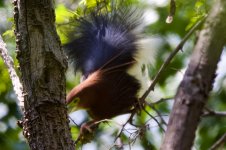

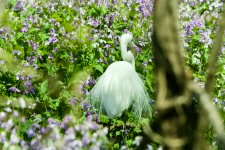
While avoiding the bus load of tourists, I went back into a wooded area and managed while trying to verify
Olive-Backed Pipit, to find both
Eurasian Collared-Dove and Oriental Turtle-Dove, both of which were easy to separately ID by their calls.
Yellow-Browed Warbler were scattered throughout the foliage and both
Great Spotted Woodpecker and
Gray Headed Woodpecker flitted about on the trees. While spending a fair amount of time working out a definite ID on
Yellow-Rumped Flycatcher and some very shy and dull looking
Red-Flanked Bluetail, I got a quick look through the binoculars at a
Black Drongo. I've only seen one several years ago, but that distinctive looking tail made the ID easy. Meanwhile,
Ring-Necked Pheasant crowed from all over the area and I even flushed one.
While waiting on the crowd to clear out of the rookery viewing area I poked around another side dead end path and managed to sneak up on a Black-Crowned Night Heron that was facing away from me. I already had the camera up and taking pictures by the time he noticed me only about 25 meters behind him. The closest I've every managed to get to any of the Egret/Heron without being in a hide.
Just after that I was focused on getting the image above of the Pond Heron in it's finery and didn't notice at first a pair of much smaller waders of some sort working on the starts of a typical looking heron nest of nothing more than a sparse flat platform of sticks just off to my right and even closer. I had already lowered the camera and only managed a quick look with the bins before the pair took off. I just can't seem to match what I saw with anything. Impression I got was a much smaller bird than a Night-Heron both in body and length, deep in the shade, but very dark appearing black, with medium long wader legs and most distinctive and very clear, a medium length long, downward curved, very thin bill. Maybe some white on wings, but may have been spots of sun shining through the foliage. Honestly, they looked very much like Glossy Ibis! That doesn't fit for here though, so it leaves me puzzled. I waited a bit for them to return with more nesting material, but then decided it was better to let them be and not disturb them. They may have been stealing nesting material from herons rather than constructing.
This in itself led to another interesting find as while I was standing there, my wife noticed a Wild Silk Moth cocoon artfully constructed around a small twig. The pupae inside the outer cocoon was empty, so I did slip it off the branch for a better photo.
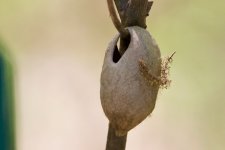
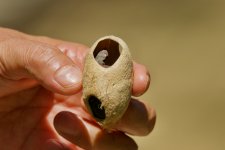
Once back into the rookery, a few of the Great Egret were sitting nests almost that close to the walkway.
A large building protruding back into the nesting area and to a waterhole is set up as a hide with benches to sit by numerous heavily tinted glass windows. That is always an interesting stop, but it was particularly productive that day producing good closeup views of
Great Egret, Gray Heron, Purple Heron, Chinese Pond Heron, Reed Parrotbill, Vinous-Throated Parrotbill, Black-Crowned Night-Heron, Tiaga Flycatcher and an
Oriental Magpie that would fly up to the exterior window ledge and knock on the window if he heard you talking inside. I'm pretty sure that it was hoping you would open the window and slip it a treat.
While checking out a new orchard area we spotted a brightly colored
White-Throated Rock Thrush, a special treat!
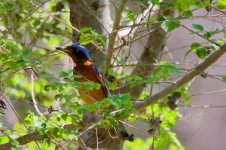
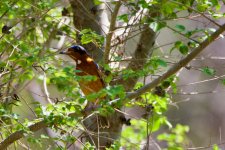
Checking out some isolated ponds while unsuccessfully trying to find some Penduline-Tit I found a small number of
Greenshank, Black-Bellied Plover and Gray-Headed Lapwing as well as more of the various herons. Finally, on the way out, numerous
Oriental Magpie and a few
Chinese Bulbul and Tree Sparrow.
Ring-necked Pheasant (Phasianus colchicus) 8
Oriental Turtle-Dove (Streptopelia orientalis) 4 Positive ID by call
Eurasian Collared-Dove (Streptopelia decaocto) 4 Positive ID by call
Black-bellied Plover (Pluvialis squatarola) 2
Gray-headed Lapwing (Vanellus cinereus) 2
Common Greenshank (Tringa nebularia) 5
Gray Heron (Ardea cinerea) 5
Purple Heron (Ardea purpurea) 25
Great Egret (Ardea alba) 50
Intermediate Egret (Ardea intermedia) 4
Little Egret (Egretta garzetta) 10
Cattle Egret (Eastern) (Bubulcus ibis coromandus) 8
Chinese Pond-Heron (Ardeola bacchus) 50
Black-crowned Night-Heron (Nycticorax nycticorax) 25
Eurasian Hoopoe (Upupa epops) 5
Great Spotted Woodpecker (Dendrocopos major) 1
Gray-headed Woodpecker (Picus canus) 2
Black Drongo (Dicrurus macrocercus) 1
Oriental Magpie (Pica serica) 30
Light-vented Bulbul (Pycnonotus sinensis) 4
Yellow-browed Warbler (Phylloscopus inornatus) 10
Reed Parrotbill (Paradoxornis heudei) 6
Vinous-throated Parrotbill (Sinosuthora webbiana) 8
Red-flanked Bluetail (Tarsiger cyanurus) 6
Yellow-rumped Flycatcher (Ficedula zanthopygia) 4
Taiga Flycatcher (Ficedula albicilla) 2
White-throated Rock-Thrush (Monticola gularis) 1
Eurasian Tree Sparrow (Passer montanus) 10
Olive-backed Pipit (Anthus hodgsoni) 4






